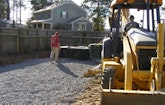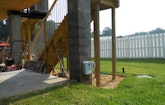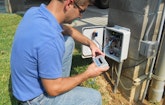
Interested in Drainfield Media?
Get Drainfield Media articles, news and videos right in your inbox! Sign up now.
Drainfield Media + Get AlertsOwners of a 94- by 126-foot lot on Lake Blackshear in Cordele, Ga., could not build because the Crisp County Health Department deemed the site unacceptable for a conventional onsite system.
The couple hired a soil scientist, then took the study and plans for a two-bedroom seasonal cabin to designer Matt Vinson of Vinson Septic Solutions in Milledgeville, Ga. “The soil had good drainage,” he says. “The issues were the water table at 20 inches below grade and drainfield space limitations.”
Other concerns were the 50-foot setback from the lake, the requirement for an alternative system to have a replacement drainfield, intermittent usage, and maintenance. The couple planned to visit the cabin on weekends during the summer and probably monthly in winter.
Vinson chose a Puraflo peat fiber biofiltration pretreatment system from Anua with direct discharge. “Besides meeting the other criteria, Puraflo systems produce Class 1 effluent,” says Vinson. “That allowed us to reduce the separation from the water table and minimize the size of the gravel and replacement beds.” Brian Lucas of Lucas Soil Evaluation in Waverly Hall, Ga., installed the system.
Site conditions
Soils are Albany (loamy) with a percolation rate of 30 minutes per inch. The water table is 20 inches below grade. The long side of the lot parallels the lake.
System components
Vinson designed the system to handle 300 gpd. Major components are:
1,000-gallon low-profile molded plastic septic tank (Infiltrator Systems)
Effluent filter from Tuf-Tite
500-gallon dosing tank with Zoeller 1/3 hp pump delivering 34 gpm and 10 feet total dynamic head and Infiltrator Systems transducer
Two 150 gpd Puraflo peat biofilter modules from Anua on a 17- by 40-foot gravel bed 8 inches deep
Aquaworx IPC control panel from Infiltrator Systems
System operation
Wastewater flows by gravity through 4-inch PVC pipe to the septic tank, then into the dosing tank. Every two hours, the dosing pump sends 25 gallons through a 1.5-inch PVC Schedule 40 force main to the tops of the modules. Effluent trickles through 30 inches of packed peat fiber with a retention time of 48 hours, then falls into a 6-inch-deep gravel layer at the bottoms of the modules before entering the gravel absorption bed.
“Peat fiber, unlike sphagnum peat moss, is very dense and so positively charged that it quickly leaches any ions not connected to the water,” says Lucas. “The fibers act almost like magnets.”
When the cabin is vacant for extended periods, microorganisms living on the media go dormant, but they reactivate to optimal performance levels shortly after the homeowners return. Effluent averages less than 10 mg/l TSS and BOD with 99 percent reduction in fecal coliforms with no pathogens.
Installation
Workers used a full-sized John Deere backhoe to excavate for the septic and pump tanks in the 30- by 40-foot yard beside the cabin. “Matt chose a low-profile septic tank because we didn’t want to dig a deep hole, hit water, and have it float,” says Lucas.
He prepared to dewater the excavation, but only a little water bled in. The crew immediately set the tank, leveled it, and half-filled it with water. The dosing tank was then installed. Once the tank levels were verified, they were backfilled up to the flanges.
The fenced corner of the yard for the treatment system had roots and thatch. “We wanted to reuse the soil for cover, so we dragged the teeth on the bucket through each pile to remove the roots as we excavated down eight inches,” says Lucas. “It took quite a bit longer than planned, but the effort paid off.”
After shooting grades at 30 points to maintain the bed’s natural slope, the crew added and leveled the No. 5 washed gravel, then set the 1,800-pound modules using the backhoe and a lifting harness. The components were then plumbed.
“We use spa pipe to connect the modules to the tees on the force main,” says Lucas. “Getting the fittings to line up exactly is sometimes tricky, but spa pipe is flexible and glues well to PVC. It saves a lot of time.”
Workers then sloped gravel shoulders around the weep holes at the bases of the modules to prevent clogging from soil and particles. The units are exposed per the homeowner’s preference.
Vinson selected the Aquaworx IPC (intelligent pump control) control panel because it uses a transducer attached to the top of the dosing tank instead of floats. “The transducer is reliable, the panel is easy to program, and it logs data for troubleshooting and checking system operation,” he says.
An emergency override doses the modules if the effluent level rises too high. The panel then resets itself. A supplied handheld device downloads the data in spreadsheet format for troubleshooting the system. Telecommunications is optional.
Maintenance
The owners have a maintenance contract with the installer. Lucas will visit the system twice per year. A chamber mounted to the side of one module enables him to grab effluent test samples. He also downloads data from the control panel.









